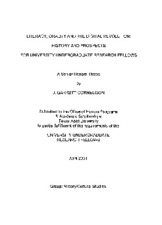| dc.contributor.advisor | Swearingen, Jan C. | |
| dc.creator | Cornelison, J. Garrett | |
| dc.date.accessioned | 2013-02-22T20:40:32Z | |
| dc.date.available | 2013-02-22T20:40:32Z | |
| dc.date.issued | 2001 | |
| dc.identifier.uri | https://hdl.handle.net/1969.1/ETD-TAMU-2001-Fellows-Thesis-C667 | |
| dc.description | Digitized from print original stored in HDR. Due to the character of the original source materials and the nature of batch digitization, quality control issues may be present in this document. Please report any quality issues you encounter to digital@library.tamu.edu, referencing the URI of the item. | en |
| dc.description | Includes bibliographical references (leaf 51). | en |
| dc.description | Program year: 2000/2001 | en |
| dc.description.abstract | For years, communications scholars have classified communication into two types, oral and literate. Oral communication is, of course, basic to humans. We are bom with the ability to speak and need no formal training in language. We simply learn the language that is spoken around us. Literate forms of communication, however, must be taught; we have no instincts as human beings for acquiring the ability to read and write. According to communications scholars such as Walter Ong and Marshall McLuhan, when an individual becomes literate, the written word became not just a vessel for communication, but a device that restructures her consciousness. Leonard Shlain extends this principle by arguing that literacy shifts a person's mental dependence from the right brain to left brain. The right hemisphere of the brain is the domain of oral communication - it is holistic and intuitive. The left hemisphere is the domain of logic, sequence and order. According to Shlain and other scholars, shifting from a right to a left brain dominance allowed for the creation of classical philosophy and the sciences as a result of the abstract thought that is made possible through literacy. The Digital Revolution, involving our new technologically advanced forms of communication such as the television, radio, the world wide web, email and others, is transforming our consciousness in a manner akin to the ways in which it was transformed by the Chirographic and Typographic revolutions. However, instead of dividing the two types of communicative devices, oral and literate, right brain and left brain, the communications revolution is fusing them. The dividing line that communications scholars have placed between oral and literate forms of communication is becoming increasingly meaningless in our "global village." Instead of thinking and speaking of new media forms in old terms such as "orality" and "literacy," we should instead be venturing forward with revised ways of thinking and speaking about our communicative devices. Instead of speaking in terms of "orality" and "literacy," we should instead be focusing on the ways in which our newest communicative forms are fusing aspects of both oral and literate communications into a hybridized structure. | en |
| dc.format.extent | 57 pages | en |
| dc.format.medium | electronic | en |
| dc.format.mimetype | application/pdf | |
| dc.language.iso | en_US | |
| dc.rights | This thesis was part of a retrospective digitization project authorized by the Texas A&M University Libraries in 2008. Copyright remains vested with the author(s). It is the user's responsibility to secure permission from the copyright holder(s) for re-use of the work beyond the provision of Fair Use. | en |
| dc.subject | communication | en |
| dc.subject | cultural studies. | en |
| dc.subject | Digital Revolution | en |
| dc.subject | forms of communication | en |
| dc.subject | orality | en |
| dc.subject | literacy | en |
| dc.title | Literacy, Orality and the Digital Revolution: History and Prospects | en |
| dc.title.alternative | Literacy, orality annd the digital revolution: history and prospects for university undergraduate research fellows | en |
| dc.type | Thesis | en |
| thesis.degree.department | English | en |
| thesis.degree.grantor | University Undergraduate Research Fellow | en |
| thesis.degree.name | Fellows Thesis | en |
| thesis.degree.level | Undergraduate | en |
| dc.type.material | text | en |
| dc.format.digitalOrigin | reformatted digital | en |


